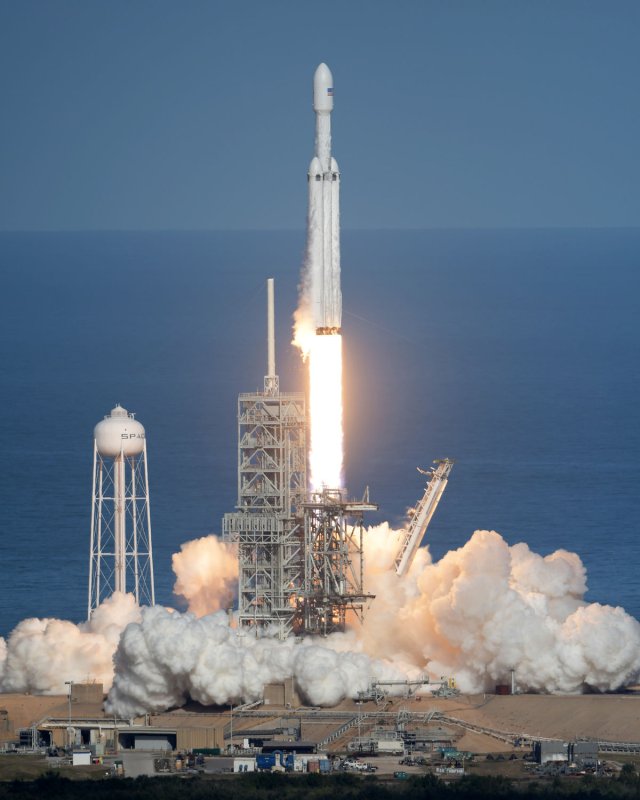1 of 5 | The first SpaceX Falcon Heavy lifts off at 3:45 pm from historic Launch Complex 39A at the Kennedy Space Center in Florida on Tuesday. The inaugural launch sent Elon Musk's Tesla Roadster on a mission that will send the vehicle to Mars in a demonstration of the rocket's capabilities. Photo by Joe Marino/Bill Cantrell/UPI |
License Photo
Feb. 6 (UPI) -- SpaceX launched the world's most powerful rocket, the Falcon Heavy, for the first time on Tuesday afternoon. After delaying the launch five times, the megarocket finally blasted-off at 3:45 p.m. ET.
Falcon Heavy launched from pad LC-39A at NASA's Kennedy Space Center in Florida.
The rocket successfully launched, throttled down and executed both booster and stage separations. SpaceX successfully landed the two side boosters back at Kennedy Space Center minutes after launch.
The second stage reached low-Earth orbit, cut off its engine and is now en route toward Mars.
The second stage is carrying Elon Musk's Tesla Roadster. Inside the car is a dummy in a spacesuit. David Bowie's "Space Oddity" is playing on the stereo. The Roadster is being put into an elliptic orbit toward Mars and will then eventually head back toward the sun. Musk said the car and driver could be in their "hyperbolic orbit" for a billion years.
The inaugural launch and test flight was broadcast live online.
Falcon Heavy is essentially three regular Falcon 9 rocket boosters strapped together. The rocket boasts a total of 27 engines, which can generate 5 million pounds of thrust at liftoff -- equivalent to eighteen 747 aircraft.
"Falcon Heavy can lift more than twice the payload of the next closest operational vehicle, the Delta IV Heavy, at one-third the cost," the company claims on its website.
While other rocket companies have looked to downsize, SpaceX has gone big -- really big. And its powerful new rocket has captured the attention of many in the space world.
Elon Musk teased his followers with pictures of the fully assembled boosters in December, and after a few delays, the rocket successfully completed a static fire of all 27 of its engines at the end of January.
Now, finally, the rocket proved it works.
The reason Falcon Heavy is so large is because Musk and SpaceX have plans to do more than launch satellites and old cars. They aim to be in the space travel business, taking both astronauts and citizens to the moon and Mars.
But while SpaceX has promised to take two paying customers on a trip around the moon in the near future, its first actual missions will involve the usual cargo. Falcon Heavy is set to carry a large communications satellite into orbit for Arabsat of Saudi Arabia. The rocket is also set to carry out a launch mission for the U.S. Air Force.















